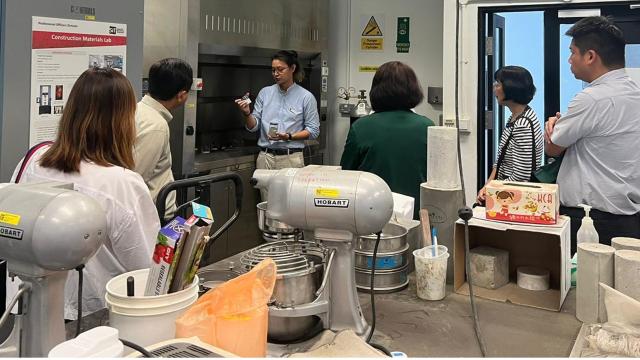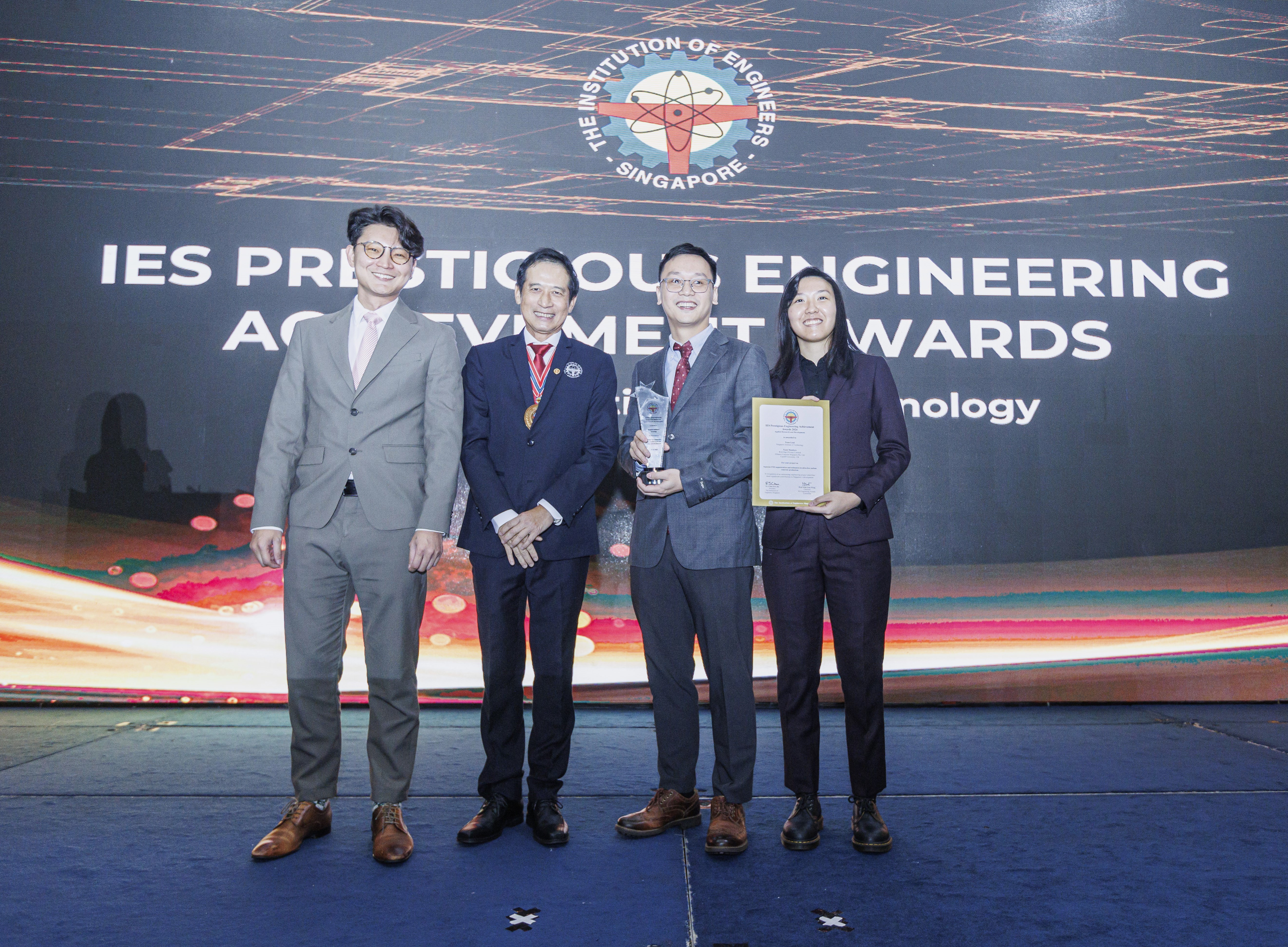Chua Guan Feng has developed a novel sustainable construction solution for his Industrial Master’s at SIT, where he acquired the building blocks for success.

Guan Feng (third from left) shared the materials used for high-strength concrete during a lab tour for Construction Technology Innovation Laboratory (CTIL) members. (Photo: Chua Guan Feng)
Developing a new construction system for industrial buildings was challenging, and Mr Chua Guan Feng faced a bigger hurdle as the work progressed. He had to present the system in Mandarin for his project, “High-Performance Pre-Engineered Steel Concrete Composite Beam (HPCB) for Sustainable Construction”, which he had completed as part of his Master of Engineering programme, an Industrial Master’s (IM) programme, at the Singapore Institute of Technology (SIT). He worked with Professor Chiew Sing Ping and Assistant Professor Zhao Ming Shan, who are the Principal Investigator and co-Principal Investigator, respectively, at SIT’s Construction Technology Innovation Laboratory (CTIL) for this project.
The 37-year-old, who began his Master of Engineering (with a specialisation in Civil Engineering) in 2022 and completed it in 2023, recounted how he had to communicate with professors from Chongqing University in China to test his HPCB system. “We could not conduct tests in Singapore because of the scale of our project, as the facilities here are not equipped to handle the length and loading required at a reasonable cost. So we worked with Chongqing University. However, communication was a challenge because I had to learn all the technical descriptions and terms in Mandarin,” he explained.
This was no small feat considering the technical complexity of the HPCB system. It involved replacing conventional structural systems used in industrial buildings to reduce their embodied carbon, which refers to the amount of equivalent greenhouse gas (GHG) emissions produced during a building’s construction.
The conventional system uses reinforced concrete, produced by filling in a skeletal framework of steel bars with concrete. “Even though concrete has low specific carbon dioxide emission of below 200 kg per tonne, its abundance makes it responsible for about 8% of man-made carbon dioxide emissions, which has become a major contributor to climate change,” explained Guan Feng, who graduated with a Bachelor’s degree in Civil Engineering with the highest distinction from SIT and currently works at SIT as a research engineer.
Guan Feng’s HPCB system optimises the design of composite beams by pre-engineering the steel sections to handle the forces they are expected to take. Unlike conventional universal beams that are symmetrical and efficient for standalone applications, the pre-engineered design minimises the size of the top flange and web – parts that do not significantly affect the load-bearing capacity of the beam. By using less steel than conventional beams, the composite beam becomes lighter and eliminates any compression on the steel, which would weaken its ability to support loads.
“The HPCB system makes use of the natural strengths of the materials. Concrete, which is strong under compression, handles all the compressive forces, while steel, which is good with tension, only experiences tension. This efficient combination reduces the weight of the beams significantly, and reduces embodied carbon because less materials are used,” Guan Feng explained.
According to his calculations, the HPCB system cuts embodied carbon by approximately 41 per cent and increases construction productivity and efficiency by 15 per cent. These improvements help to contribute substantially to meeting important targets for decarbonising the construction process.
Cementing His Knowledge at SIT

Guan Feng was the emcee for the CTIL Annual Seminar 2023 at SIT@Dover. (Photo: Chua Guan Feng)
Guan Feng attributes his success in developing this innovative solution to his time at SIT. As the system is a novel one, formulas had to be derived from scratch. “The IM helped to enhance my understanding of the stress-strain compatibility of steel and concrete, which I could apply to come up with advanced mathematical models and devise formulas,” he explained.
SIT’s IM and Industrial Doctorate (ID) programmes are part of the university’s Industrial Postgraduate programmes. These allow professionals to deepen their specialist knowledge while staying employed. The research-based programmes not only champion innovation while deepening knowledge, but also equip students with a range of soft skills relevant to their work.
One such soft skill that Guan Feng picked up was communication. “This was particularly useful when liaising with Chongqing University because we use the European codes for technical construction standards while they use the Chinese codes. So it took some time to explain and tweak our specifications to fulfil our requirements.”
He also became more competent at delivering presentations, a skill he has used to promote the HPCB system. During his IM, Guan Feng travelled to Portugal in 2023 for the XIV Conference on Steel and Composite Construction, an annual conference organised by the Portuguese Association of Metallic and Mixed Construction, to present his novel solution to international academia and industry players.
His efforts culminated on 30 August 2024, when the HPCB system was launched officially at the JTC Industry Seminar on Innovations in Structural Engineering Systems, making it available for construction firms to adopt. The system has also been documented in a newly published design book by leading academic publisher Taylor & Francis, titled “Design of High-performance Pre-engineered Steel Concrete Composite Beams for Sustainable Construction”, which is on sale internationally.
As the HPCB system gains traction, Guan Feng believes it can make a “huge contribution” to Singapore’s net-zero ambition with its “statistically proven carbon reduction and cost-effectiveness”.
Laying Foundations for a Greener Future
Guan Feng is now pursuing his Doctor of Engineering, an ID programme, at SIT, which began in January this year. “Doing the ID was always the plan, and the master’s served as a trial to see if I was suitable for it. I enjoyed the satisfaction and enjoyment I got from overcoming tough challenges during my master’s programme.”

Guan Feng and his team at SIT for his ID project, receives the 2024 IES Prestigious Engineering Achievement Award from Er. Chan Ewe Jin, President of the Institution of Engineers, Singapore (IES). From left: Chua Guan Feng; Er. Chan Ewe Jin; Asst Professor Zhao Ming Shan; and Jamie Chong. (Photo: IES)
For his ID, which he aims to complete by 2028, Guan Feng has embarked on a new project titled “Waste Valorisation in Concrete Production via CO2 Sequestration”. He is developing a feasible solution for low-carbon concrete that can reduce up to 60 per cent of embodied carbon. Working alongside Asst Prof Zhao Ming Shan, Principal Investigator, and Jamie Chong, Research Engineer at SIT, the project is led by SIT in collaboration with Woh Hup, Alliance Concrete Singapore, and Cardiff University. This effort earned his team the 2024 IES (Institution of Engineers) Prestigious Engineering Achievement Award, which honours outstanding engineering achievements in Singapore.
Explaining why he chose to work on another sustainability-geared project, he said, “It hasn’t always been my interest, but it’s clear that global warming is getting worse. As a parent myself, I want to create sustainable solutions not only for myself but also for the future generation. We may not be able to solve global warming now, but we can at least delay it so that the next generation, like my two children, can have a chance to solve it.”
![[FA] SIT One SITizen Alumni Initiative_Web banner_1244px x 688px.jpg](/sites/default/files/2024-12/%5BFA%5D%20%20SIT%20One%20SITizen%20Alumni%20Initiative_Web%20banner_1244px%20x%20688px.jpg)


